1996 PONTIAC GRAND-AM service
[x] Cancel search: servicePage 239 of 356
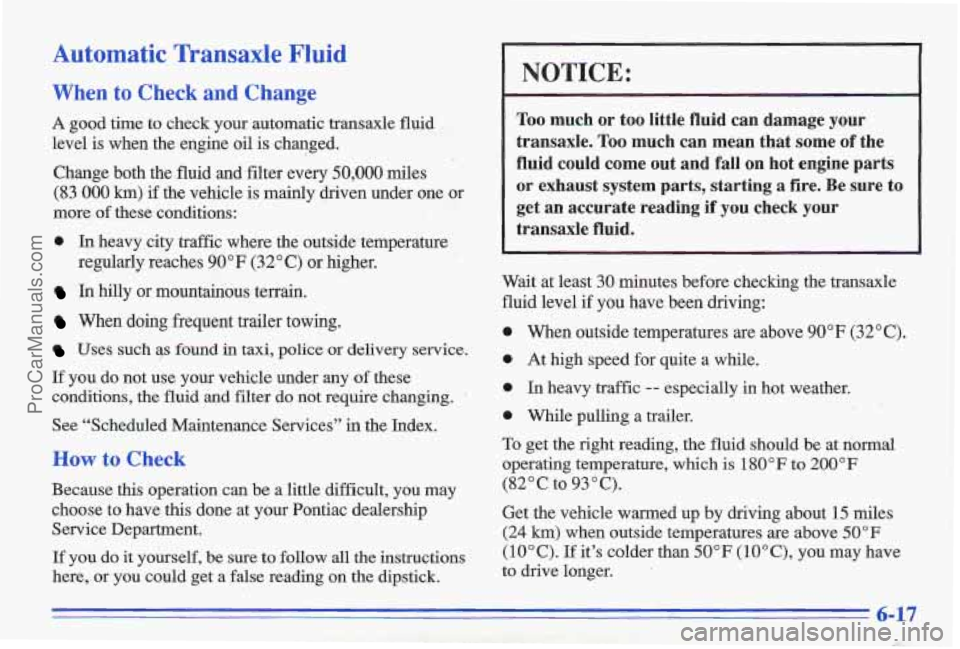
Automatic Transaxle Fluid
When to Check and Change
A good time to check your automatic transaxle fluid
level is when the engine oil is changed.
Change both the fluid and filter every
50,000 miles
(83 000 km) if the vehicle is mainly driven under one or
more of these conditions:
0 In heavy ,city traffic where the outside, temperature
In hilly or mountainous terrain.
When doing frequent trailer towing.
Uses such zp found in taxi, police or delivery service.
If you do not use your vehicle under any of these
conditions, the fluid and
filter do not require changing.
See “Scheduled Maintenance Services”
in the Index.
How to Check
Because this operation can be a little difficult, you may choose to have this done at your Pontiac dealership Service Department.
If you do it yourself, be sure to follow all the instructions
here, or
you could get a false reading on the dipstick.
regularly reaches
90°F (32°C)
or higher.
NOTICE:
Too much or too little fluid can damage your
transaxle.
Too much can mean that some of the
fluid could come out and fall on hot engine parts
or exhaust system parts, starting a fire. Be sure to
get an accurate reading if you check your
transaxle fluid.
Wait at least 30 minutes before checking the transaxle
fluid level
if you have been driving:
0 When outside temperatures are above 90°F (32°C).
0 At high speed for quite a while.
0 In heavy traffic -- especially in hot weather.
0 While pulling a trailer.
To get the right reading, the fluid should be at normal
operating temperature, which
is 180°F to 200°F
(82°C to 93°C).
Get the vehicle warmed up by driving about 15 miles
(24 krn) when outside temperatures are above 50°F
(10°C). If it’s colder than 50°F (lO°C), you may have
to drive longer.
ProCarManuals.com
Page 242 of 356
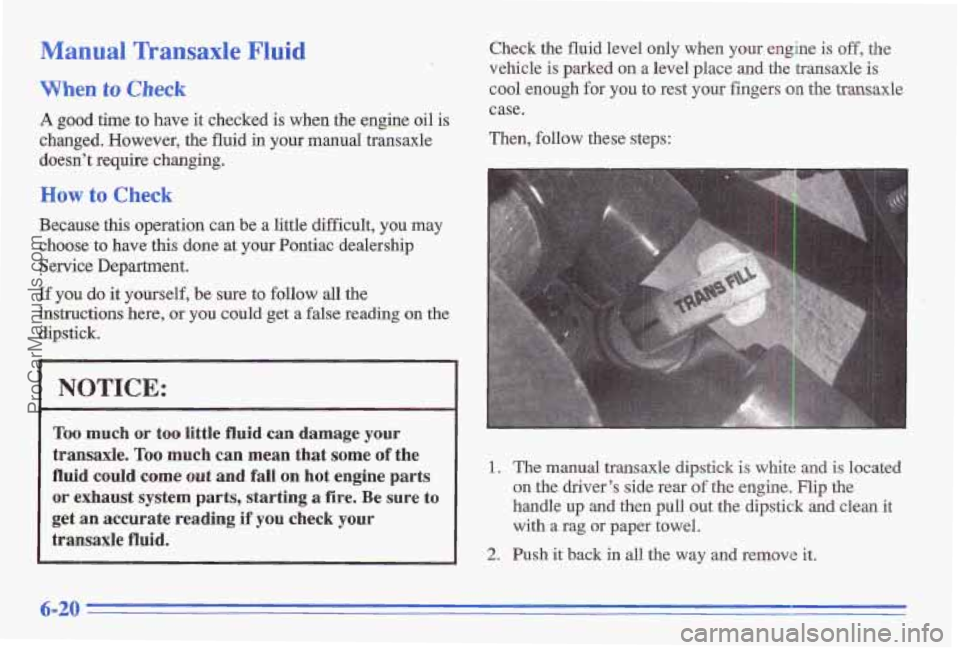
Manual Transaxle Fluid
When to Check
Check the fluid level only when your engine is off, the
vehicle
is parked on a level place and the transaxle is
cool enough for
you to rest your fingers on the tJransaxle
A good time to have it checked is when the engine oil. is
changed. However, the fluid in your manual transaxle Then, foll\
ow these steps:
doesn't require
changing.
case.
How to Check
Because this operation can b'e a little difficult, you may
choose to have this done at your Pontiac dealership
Service Department.
iG Jf you do it yourself, be sure to follow all the , .,..!%$i- k%4nstructions here, or you could get a false reading on the
,> , . ".
dipstick.
I
NOTICE:
Too much or too little fluid can damage your
transaxle. Too much can mean that some of the
fluid
could come out and fall on hot engine parts
or exhaust system parts, starting a fire. Be sure to
get an accurate reading if you check yuur
transaxle fluid.
1, The manual transaxle dipstick is white and is located
on the driver's side rear of the engine. Flip the
handle up and then pull out the dipstick and clean it
with a rag or paper towel.
2. Push it back in all the way and remove it.
6-20
ProCarManuals.com
Page 244 of 356
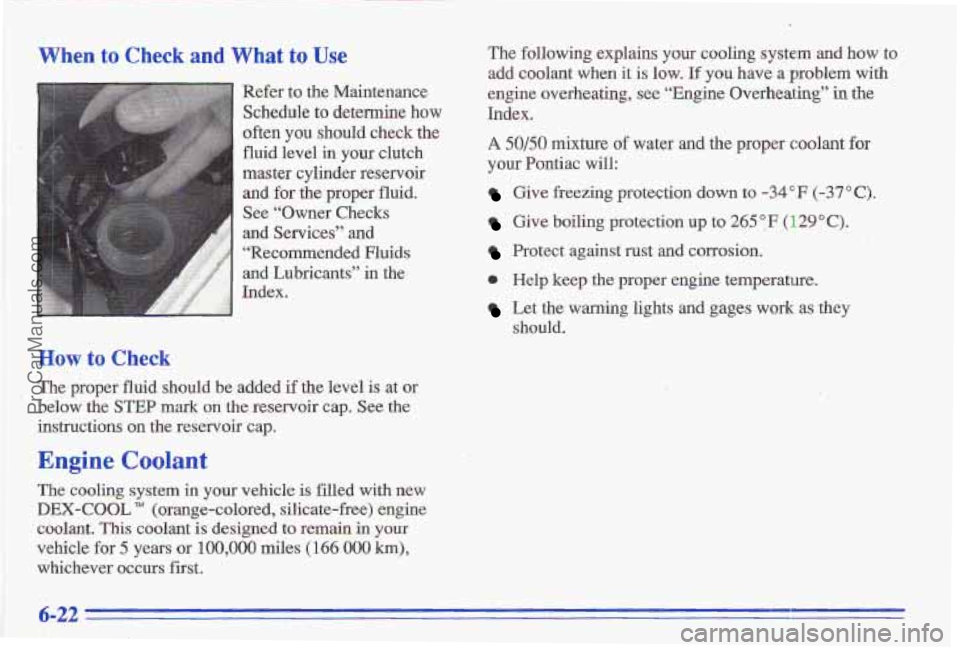
When to Check and What to Use
Refer to the Maintenance
Schedule
to determine how
often you should check the
fluid level
in your clutch
master cylinder reservoir and for
the proper fluid.
See “Owner Checks
and Services” and
“Recommended Fluids
and Lubricants” in the
How tu Check
The proper fluid should be added if the level is at or
below the
STEP mark on the reservoir cap. See the
instructions
on the reservoir cap.
Engine Coolant
The cooling system in your vehicle is filled with new
DEX-COOL TM (orange-colored, silicate-free) engine
coolant.
This coolant is designed to remain in your
vehicle
for 5 years or 100,000 miles (166 000 h),
whichever occurs first. The
following explains
your cooling system and how to
add coolant when it is low. If you have a problem with
engine overheating, see “Engine Overheating”
in the
Index.
A Sol50 mixture of water and the proper coolant for
your Pontiac will:
Give freezing protection down to -34°F (-37°C).
Give boiling protection up to 265 9 F ( 129 O C).
Protect against rust and corrosion.
0 Help keep the proper engine temperature.
Let the warning lights and gages work as they
should.
6-22
ProCarManuals.com
Page 252 of 356
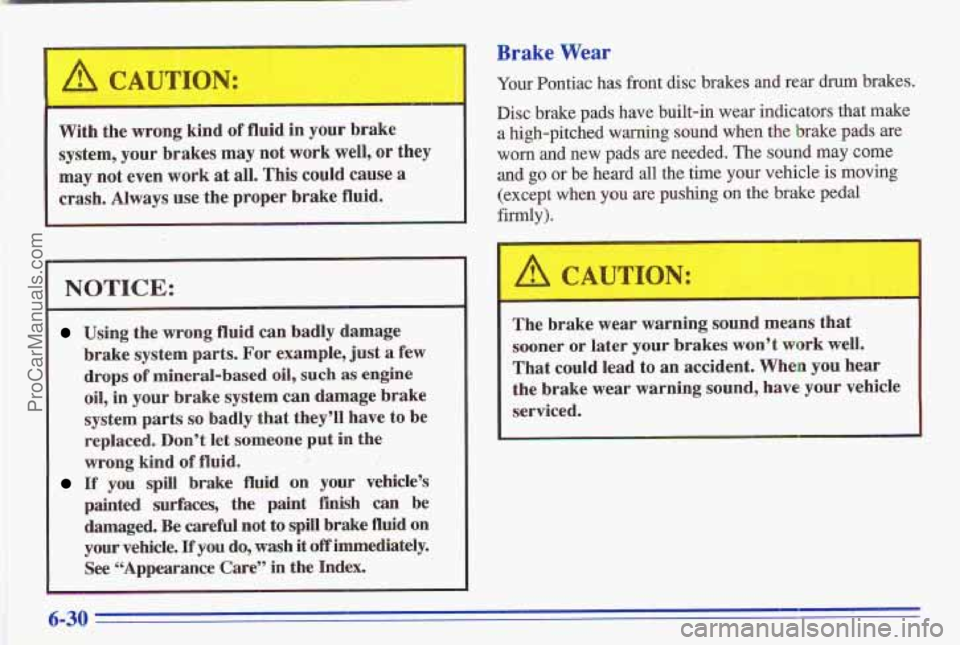
With the wrong kind,of fluid in your brake
system, your brakes
may not work well, or they
may not even work
at all, This could cause a
crash. Always use the moper brake fluid.
NOTICE:
Using the wrong fluid can badly damage
brake system park.
For example, just a few
drops
of mineral-based oil, such as engine
oil, in your brake system can damage brake
system
parts so badly that they’ll have to be
replaced. Don’t
let someone put in the
wrong kind of fluid.
If you spill brake fluid on your vehicle’s
painted surfaces, the paint
finish can be
damaged. Be careful not to spill brake fluid on
your vehicle, If you do, wash it off immediately.
See “Appearance Care” in
the Index.
i ‘I I .- ’;/
Brake Wear
Your Pontiac has front disc brakes and sear drum brakes.
Disc brake pads have built-in wear indicators that make
a high-pitched warning sound whew the brake pads are
worn and new pads are needed. The sound may come
and go or be heard all the time your vehicle is moving
(ex’cept when
you are pushing on.the brake pedal
firmly).
The brake wear warning sound means that
sooner
or later your brakes wonY work well.
That could lead
to an accident. When you hear
the brake wear warning sound, have your vehicle
serviced.
6-30
ProCarManuals.com
Page 259 of 356
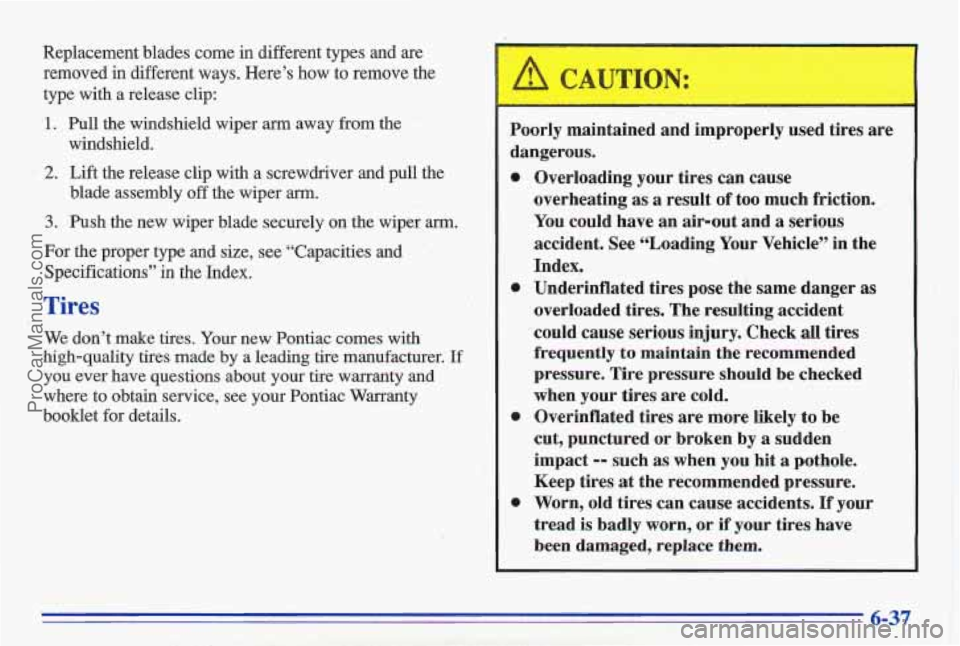
Replacement blades come in different types and are removed in different ways. Here’s how to remove the
type with a release clip:
1. Pull the windshield wiper am away from the ‘
2. Lift the release clip with a screwdriver and pull the
3. Push the new wiper blade securely on the wiper arm.
For the proper type and size, see “Capacities and
Specifications”
in the Index.
windshield.
blade assembly
off the wiper arm.
Tires
We don’t make tires. Your new Pontiac comes with
highquality tires made by a leading tire manufacturer. If
you ever have questions about your tire warranty and
where to obtain service, see your Pontiac Warranty
booklet for details.
.-
Poorly maintained and improperly used tires are
dangerous.
Overloading your tires can cause
overheating as
a result of too much friction.
You could have an air-out and a serious
accident. See “Loading Your Vehicle” in the
Index.
Underinflated tires pose the same danger as
overloaded tires. The resulting accident
could cause serious injury.
Check all tires
frequently
to maintain the recommended
pressure. Tire pressure should be checked
when your tires are cold.
Overinflated tires are more likely
to be
cut, punctured or broken
by a sudden
impact
-- such as when you hit a pothole.
Keep tires at the recommended pressure.
Worn, old tires can cause accidents.
If your
tread is badly worn, or
if your tires have
been damaged, replace
them.
6-37
ProCarManuals.com
Page 261 of 356

Tire Inspection and Rotation
Tires should be inspected every 6,000 to 8,000 miles
(10 000 to 13 000 km) for any signs of unusual wear.
If unusual wear is present, rotate your tires as soon as
possible and check wheel alignment. Also check for damaged tires or wheels. See “When It’s Time for New
Tires” and “Wheel Replacement” later in this section for
more information. When rotating your tires, always use the correct rotation
pattern shown here.
Don’t include
the compact.spa.re tire in your tire
rotation.
After the tires have been rotated, adjust the front and
rear inflation pressures as shown on the Tire-Loading
Information label. Make certain that all wheel nuts are
properly tightened. See “Wheel Nut Torque” in the
Index.
I
The purpose of regular rotation is to achieve more
uniforrn wear for all tires on the vehicle. The first
rotation is the most important. See “Scheduled Maintenance Services”
in the Index for scheduled
rotation intervals.
--
Rust or dirt on a wheel, lr on the part D which
it is fastened, can make wheel nuts become loose
after
a time. The wheel could come off and cause
an accident. When
you change a wheel, remove
any rust or- dirt from places where the wheel
attaches to the vehicle. In an emergency,
you can
use
a cloth or a paper towel to do this; but be
sure to use
a scraper or wire brush later, if you
need to, to get all the rust or dirt off. (See
“Changing
a Flat Tire” in the ‘Index.)
6-39
ProCarManuals.com
Page 262 of 356
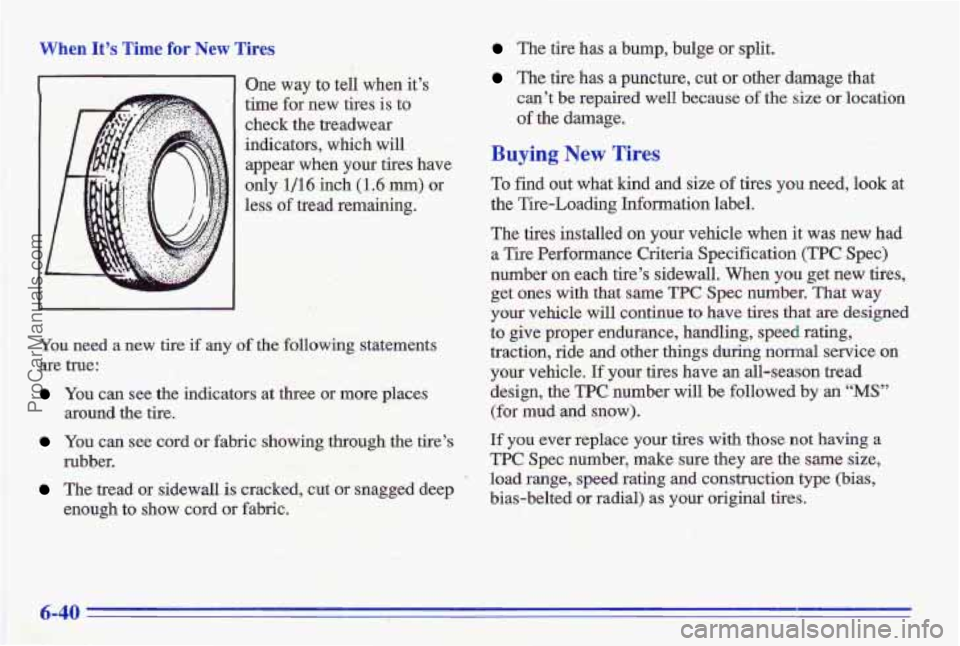
When It’s Time for New Tires
I One wav to tell when it’s
time
fcinew tiies is to
check the treadwear
indicators, which will
,.
appear when your tires have
only 1/16 inch (1.6 rrim) or
less
of tread remaining.
I
You need a new tire if any of the following statements
are true:
, 1, .” ! , .
You cdsee the indicators at three or more places
.. .. . . (. , ;.--.-$ _. . .I :: , L. -. , &&&
-. .. . .I , .I 1 -
around the tire.
You can see cord or fabric showing through the tire’s
The tread or sidewall is cracked, cut or snagged deep
rubber.
enough to
show cord or fabric.
The tire has a bump, bulge or split.
The tire h’as a puncture, cut or other damage that
can’t be repaired
well because of the size or lo’cation
of the damage.
Buying New Tires
To find out what kind and size of tires you need, look at
the Tire-Loading Information label.
The
tires installed on your vehicle when it was new had
a Tire Performance Criteria Specification (TPC Spec)
number
on each tire’s sidewall. When you get new tires,
get ones with that same
TPC Spec number. That way
your vehicle will continue to have tires that are designed
to give proper endurance, handling, speed rating,
traction, ride
and other thing’s during normal service on
your vehicle. If your tires have an all-season tread
design, the
TPC number will be followed by an “MS”
(for mud and snow).
If you ever replace your tires with those not having a
TPC Spec nuhber, make sure they are the same size,
load
range, speed rating &d construction type (bias,
bias-belted
or radial) as your original tires.
..
6-40
ProCarManuals.com
Page 263 of 356
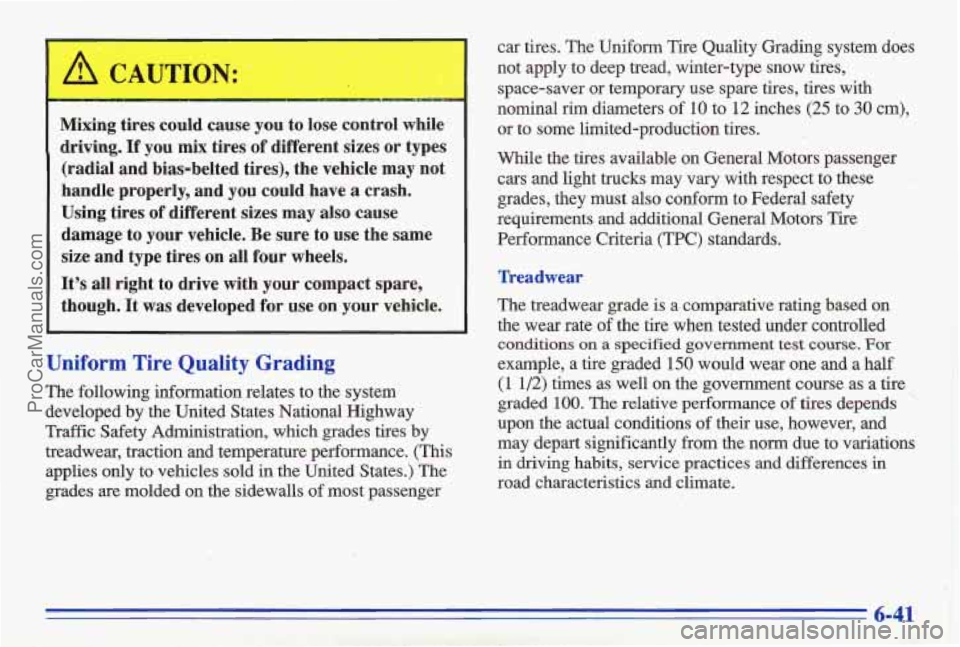
Mixing tires could cause you to lose control while
driving. If you mix tires of different sizes or types
(radial and bias-belted tires), the vehicle may not
handle properly, and you could.have
a crash.
Using tires of different sizes may also cause
damage to your vehicle. Be sure to use the same
size and type tires on all four wheels.
It's all right to drive with your compact spare,
though. It was developed for use on your vehicle.
Uniform Tire Quality Grading
The following information relates to the system
developed by the United States National Highway
Traffic Safety Administration, which grades tires by
treadwear, traction and temperature performance. (This applies only to'vehicles sold in the United States.)
The
grades are molded on the sidewalls of most passenger car tires. The Uniform Tire Quality Grading system does
not apply to deep tread, winter-type snow tires,
space-saver or temporqy use spare tires, tires with
nominal rim diameters of
10 to 12 inches (25 to 30 cm),
or to some limited-production tires.
While the tires available on General Motors passenger cars and light trucks may vary with respect to these
grades, they must also conform to Federal safety
requirements and additional General Motors Tire
Performance Criteria (TPC) standards.
Treadwear
The treadwear grade is a comparative rating based on
the wear rate
of the tire when tested under controlled
conditions on a specified government test course. For
example, a tire graded 150 would wear one and a half
(1 1/2) times as well on the government course as a tire
graded
100. The relative performance of'tires depends "
upon the actual conditions of their use, however, and
may depart significantly from the norm due to variations
in driving habits, service practices and differences in
road characteristics and climate.
ProCarManuals.com